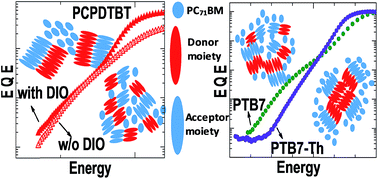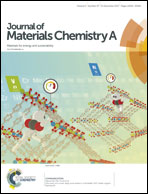Interfacial disorder in efficient polymer solar cells: the impact of donor molecular structure and solvent additives†
Abstract
The performance of bulk heterojunction (BHJ) organic solar cells (OSCs) strongly depends on the intermolecular packing of donor:acceptor (D:A) molecules, as it directly influences the photo-physics and charge transfer properties of the blend. Intermolecular packing can be tuned by solvent additives and/or the chemical structure of molecules to optimize the performance of OSCs. Three high efficiency polymer:fullerene systems are investigated based on the donor polymers PCPDTBT, PTB7 and PTB7-Th (also known as PBDTTT-EFT). For the PCDPTBT:PC71BM system, we demonstrate that the use of the solvent additive diiodooctane (DIO) which is employed to optimize the solar cell efficiency actually increases interfacial disorder by 13 meV despite lowering bulk disorder by 35 meV. In contrast, the Urbach energy (bulk and interfacial charge transfer (CT) states) and reorganization energy (λ) are minimally influenced by the addition of DIO into PTB7:PC71BM & PTB7-Th:PC71BM devices, where PTB7-Th is a chemical analogue of PTB7. However, PTB7-Th devices show remarkably low voltage losses (∼100 meV) with respect to other systems studied here, suggesting a favorable energy landscape at the D:A interface for charge separation. Hence, optimizing the molecular structure of the donor polymer can help to overcome the voltage losses even when solvent additive treatment is applied.



 Please wait while we load your content...
Please wait while we load your content...